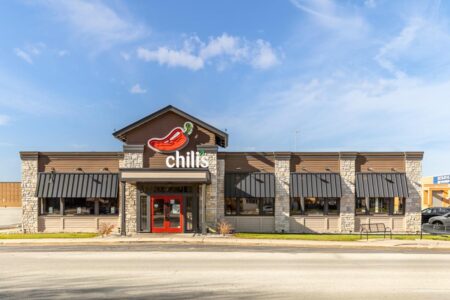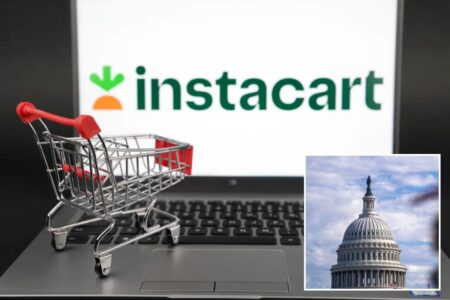The countdown to this weekend looks dismal to Kelli Austin.
Rather than looking forward to spending quality time with her children, the single mom of three is staring down the barrel of starvation.
“I don’t know how I’m going to feed my kids tomorrow,” Austin, 38, an addiction recovery coach from Augusta, Maine, told The Post through tears.
She’s just one of the 42 million Americans being stripped of their grocery budget benefits — financial support provided by the Supplemental Nutrition Assistance Program (SNAP) — on Saturday, Nov. 1.
The loss of her $300 monthly stipend means Austin, who has three teens aged between 13 and 17 — who are often teased for receiving free breakfast and lunch at school — won’t be able to put food on the table during weekends and school vacations.
And she has even greater fears for what will become of the holiday season for her family.
While the other parents will be busy piling their shopping carts with turkeys and treats, Austin worries that this will be the first time in nearly two decades that her family will go hungry.
“I’ll have to look them in the eyes and say, ‘Sorry, I couldn’t do better,’” she said.
Austin comes from “generational poverty.”
It’s a family curse she’s fought to break since working in drug rehabilitation centers over the past few years, hoping to pave a smoother path for her kids.
However, the gig doesn’t pay much, and what she earns from her job just barely covers the cost of rent for her subsidized housing, as well as other household bills.
“I’ve been a SNAP recipient for many years; those benefits feed my family,” explained Austin, who is also taking college classes in addition to working her job. “Without them, we have nothing.”
Hers is the troubling fate of low-income families, as well as the disabled and the elderly, nationwide.
“I don’t know what I’m going to do,” she further stated. “The food banks in our community are all but depleted. I have to take days off from work to wait in line at 4:00 a.m., hoping I get enough to cover us for a few days.”
“We’re not talking about luxury here,” Austin insisted. “We’re talking about basic meals, stability and dignity.”
Austin holds both the local and federal governments responsible for leaving Americans out to dry.
“I’m not a statistic, I’m your constituent,” she asserted. “You take these programs away from me, you take food out of my kids’ mouths, which jeopardizes their health. It’s ungodly.”
Stricken with several autoimmune conditions herself, Austin says taking on a second job — while juggling her current role with college and solo parenting — is virtually impossible.
“I take over nine medications every day just to be able to go to work,” she sobbed. “I’m literally doing my best — and all that families like mine need is for the government to do theirs, too.”
Lauren, 35, a single mom of two girls and a SNAP recipient, from Syracuse, agrees.
“Instead of our government showing up for its people, it wants to punish people, and that’s not leadership. Its coercion, in the most twisted way,” Lauren, a geriatric companion care provider, tells The Post.
She chose to conceal her last name.
“Sure, some people abuse the systems, but those cases are few and far between,” Lauren argued. “I am a single mother who gets up every morning, sends her kids to school, goes to work and pursues education because I want to be a benefit to the economy and society. But you feel like there’s a foot on your neck.”
The New Yorker, however, wasn’t always at the bottom of the food chain.
Shortly after starting a family with her now ex-husband, Lauren left corporate America to become a full-time stay-at-home mom.
However, when her husband recently decided to “take a different direction in life,” ending their marriage and leaving her “completely alone” with no support for the kids, Lauren had no choice but to turn to SNAP for help.
“It took me a long time to find a job that would work around my kids’ school schedule,” said the singleton, now living in a shelter with her daughters, ages 5 and 8.
It’s a temporary living situation for Lauren’s family, and she says she is working toward securing a place for herself and the girls in the near future.
The shelter, which she chose not to name, does provide one meal, four days per week, to its tenants. However, for all other meals, including snacks and beverages, residents are on their own.
“SNAP benefits were the only thing we had,” Lauren recalled of the first few months after her split. “It was very scary,”
She’s relied on the grocery money — with which she buys her kids eggs, bacon, cereal, fruits, juice, and mini croissants as a special treat — since March.
“Living in a shelter, you feel nothing but insecurity. You don’t know how long that living situation will last,” said Lauren. “SNAP has provided us security.”
“My income isn’t enough to cover the insane increase in grocery prices,” she confessed. “And now, that breath of relief that SNAP has been for my family is being taken away.”
Like Austin, without the benefits, Lauren will also be forced to turn to local food pantries and soup kitchens for support.
While national lawmakers continue their standoff in DC, in New York Gov. Kathy Hochul has vowed to allocate $65 million to emergency food providers across the state. That money is on top of $30 million of existing funding for those programs she touted earlier this week.
The state’s emergency funding will not replace existing SNAP funds. However, it will backfill organizations, including the Hunger Prevention and Nutrition Assistance Program and Nourish NY.
Still, Lauren remains fearful for the future.
“You don’t realize how strong you are until strong is all you have left,” she said. “When you’re a mother, you have to grind. But I can’t do this on my own.”
Read the full article here

















